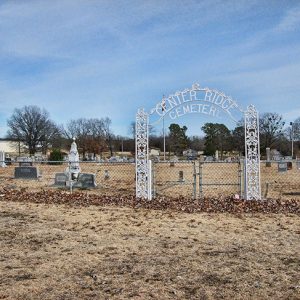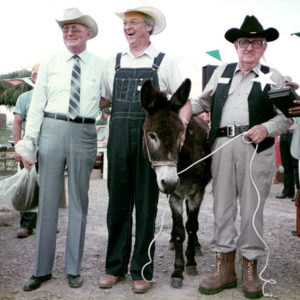calsfoundation@cals.org
Marlin Conover Hawkins (1913–1995)
Marlin Conover Hawkins served Conway County as an elected official for thirty-eight years. His ability to deliver votes to statewide and national candidates gave Hawkins a profile in state politics that was rare for a county official. His political machine is an important part of Arkansas’s political lore, and the effects of his political contacts are still evident in Conway County.
Marlin Hawkins was born on April 22, 1913, near Center Ridge (Conway County) to John Carl Hawkins and Nettie Mae Hawkins. John Carl Hawkins, a sharecropper and part-time barber, died in 1929. As the second of seven children, part of the burden of supporting the family fell on Hawkins. He worked as a sharecropper and part-time janitor until Olen Fullerton, a family friend, encouraged him to enroll in a nine-month college course in bookkeeping at Harding College, then located in Morrilton (Conway County). In 1934, Hawkins landed his first government job as a bookkeeper with New Deal program the Federal Emergency Relief Administration (FERA). In 1935, he became the Conway County Welfare Board’s first case worker as part of the Works Progress Administration (WPA). He would stay in government service for the rest of his professional career. By the age of twenty-two, Hawkins knew the daily struggles that rural Arkansans faced in the Depression, as well as the importance of help from friends.
Hawkins combined his energy, his rural roots, and his new position on the Conway County Welfare Board to find jobs and government aid for the people in his district. He joked in his autobiography about turning his “blind eye” (he had lost it at the age of eight) to the livestock that belonged to some of the people he helped. The less he reported of a family’s possessions, the more the family received in government assistance. Hawkins credited the gratitude of many of the people he helped for his 1940 victory to his first elected office, the Conway County circuit clerk and recorder. He held that office for six years, with a two-and-a-half-year hiatus during World War II from March 1943 to September 1945 to serve in the U.S. Army at Camp Robinson in North Little Rock (Pulaski County). Hawkins had persuaded the local draft board to draft him in spite of his lost eye. He was then placed in a position of restricted service, where he performed a variety of clerical duties.
In 1946, and again in 1948, Hawkins won election as the county treasurer. His dominance of the absentee voting in those elections revealed an important tool that became part of Hawkins’s machine. His supporters studied the electoral procedures to identify and use processes such as absentee voting to their advantage. Hawkins’s supporters could identify the voters that would be sympathetic, aid them in receiving an absentee ballot, and then have the extra benefit of knowing the ballot had been mailed before election day. These tactics also first raised fraud accusations that followed Hawkins throughout his public life. In 1950, when Hawkins won the Democratic nomination for sheriff by 218 votes, his opponent, Sheriff Elmer Thomas, charged Hawkins with fraud in the applications for absentee ballots. Hawkins had dominated the absentee return, 253 to 49. When his petition to contest the election was overruled, Thomas ran against Hawkins as an independent candidate in the general election, only to lose again. Hawkins began the first of twenty-eight years as the Conway County sheriff and collector.
Hawkins had crafted a highly effective political machine that was built on his personal contacts with people throughout the county. His position on the welfare board had allowed him to direct government assistance, and as sheriff, he still had access to contacts that could provide direct aid, employment, or other forms of charitable aid. Before each election, people he knew received a letter in which Hawkins personally endorsed a slate of candidates and asked for political support. Hawkins also admitted to paying poll taxes for poor voters, which was a common practice at this time, but a violation of election law nonetheless. His continued success and remarkable power lay in his ability to deliver votes for state or national candidates. This ability brought him notable opponents and equally notable favors for the county.
Hawkins, a life-long Democrat, shared Conway County with two-term governor Winthrop Rockefeller, a Republican. Rockefeller had moved to Petit Jean Mountain while Hawkins was sheriff and initially enjoyed the sheriff’s cooperation on several matters, including security at his estate. As Rockefeller became more interested in running for governor, his relationship with Hawkins deteriorated. The battle for support in Conway County pitted Rockefeller’s money against Hawkins’s influence. In each of Rockefeller’s two electoral victories as governor, he failed to carry Conway County.
Another of Hawkins’s longest-running political feuds was with Gene Wirges, editor of the local newspaper, the Morrilton Democrat. Wirges wrote several scathing stories about Hawkins on topics ranging from election irregularities, comparatively high patrol car expenses, a speed trap on Highway 64, and mishandling of fines collected. As these stories ran in the early 1960s, Hawkins also enjoyed a contradictory set of headlines, which announced some positive gains for Conway County.
Hawkins had achieved notoriety at the state level of the sort that is rare for a county official. He managed to use his political friendships with various legislators and especially Governor Orval Faubus to ensure the construction of Lake Overcup and the state’s second vocational school, now the University of Arkansas Community College at Morrilton. Hawkins personally donated twenty acres of land to guarantee the placement of the trade school in his county. Hawkins also claimed that contacts helped him land the construction of the Green Bay Packaging Paper Mill–Arkansas Kraft Division, which opened in 1966.
In 1978, Hawkins retired from public office. Hawkins’s friend George Fisher, a popular political cartoonist, placed Hawkins with contemporaries such as Orval Faubus in a fictional rest home for Arkansas politicians, called the “Old Guard Rest Home.” The popular cartoon series in the Arkansas Gazette was a fitting tribute to the impact of a generation of political personalities.
Hawkins lived in Morrilton until his death on September 16, 1995. He was survived by his wife, Marvine Treadwell Hawkins, daughter Kaye Anderson, and sons John Robert Hawkins and Donald Bruce Hawkins.
For additional information:
Conway County—Our Land, Our Home, Our People. Little Rock: Historical Publications of Arkansas, 1989.
Glaze, Tom, with Ernie Dumas. Waiting for the Cemetery Vote: The Fight to Stop Election Fraud in Arkansas. Fayetteville: University of Arkansas Press, 2011.
Hawkins, Marlin, and C. Fred Williams. How I Stole Elections: The Autobiography of Sheriff Marlin Hawkins. Morrilton, AR: 1991.
Traye D. McCool
University of Arkansas Community College at Morrilton
 Politics and Government
Politics and Government World War II through the Faubus Era, 1941 through 1967
World War II through the Faubus Era, 1941 through 1967 Center Ridge Cemetery
Center Ridge Cemetery  Old Guard Home Parody
Old Guard Home Parody 




I met Mr. Marlin in about 1936 or so when I was in the Southern Christian Home. I do believe my job was to help him to stay humble and always have something to do. After a short while, I found out I could run off almost any time, and I did. I thought I was able to go home, wherever it might be. When I would take off, I would manage to stay hid almost till dark, and the home would call the sheriff and he would find me. It was darkish when he did, and I wanted to be found. He would stop his car, run me down, spank me, pick me up and hug me, and ask me if I would like a chocolate milkshake before he returned me. What a system to get a milkshake! I think of this man so often and get to tell my story to a lot of people. He will always be tall in my book. God bless him.